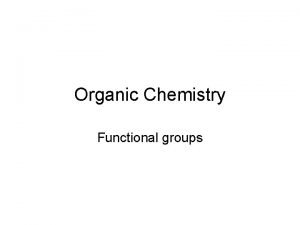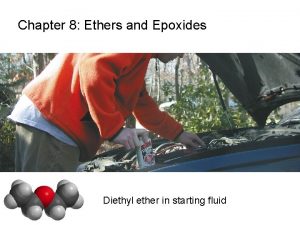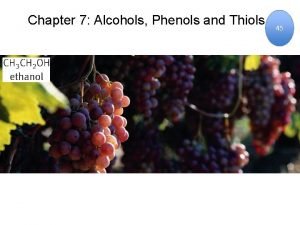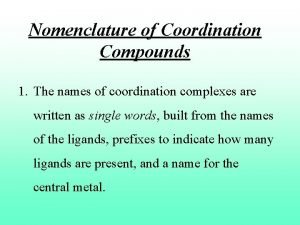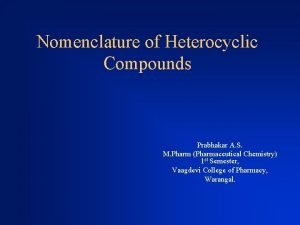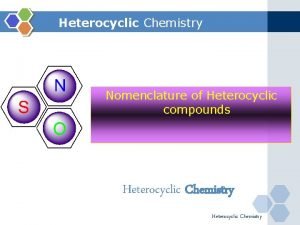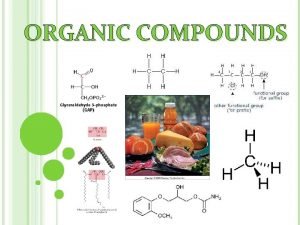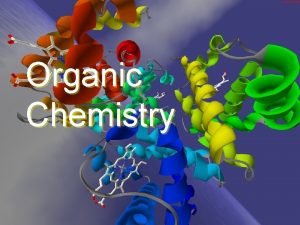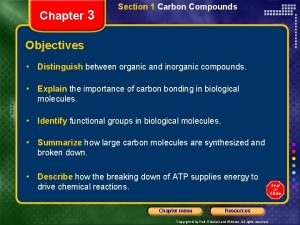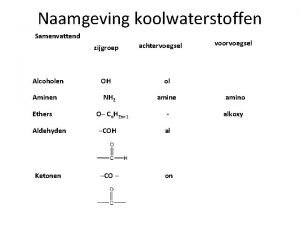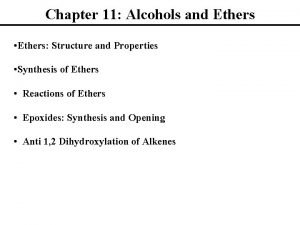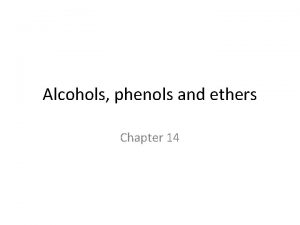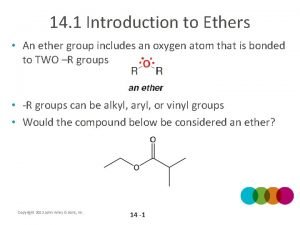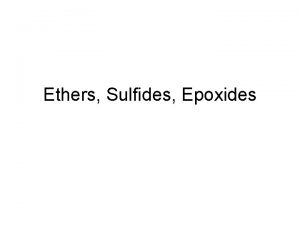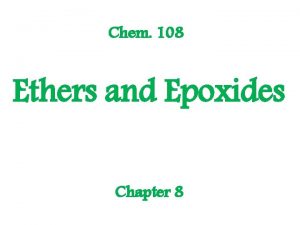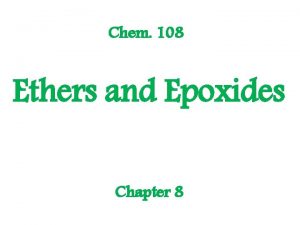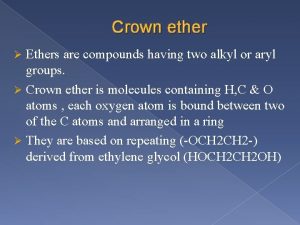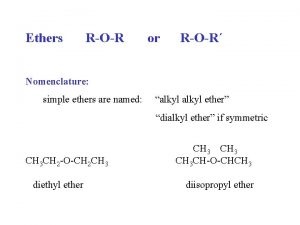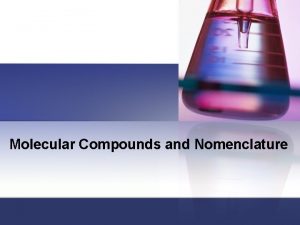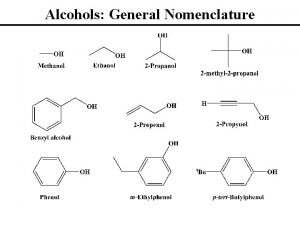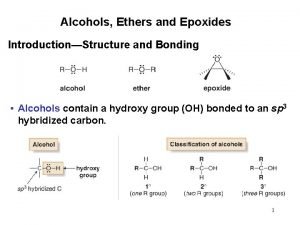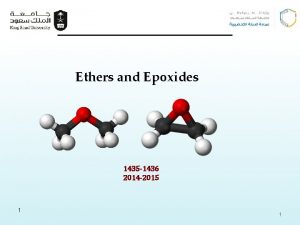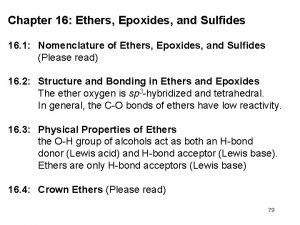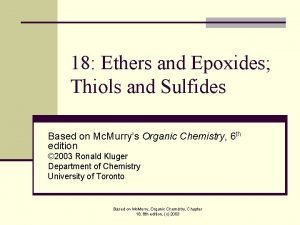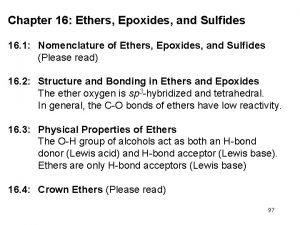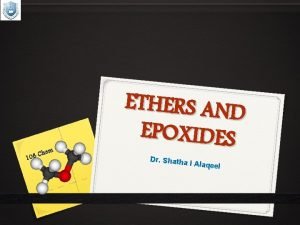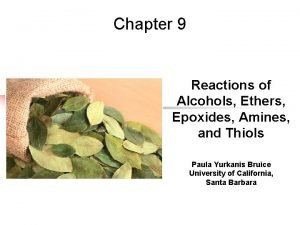Ethers Epoxides Ether Nomenclature Compounds that contain two

















- Slides: 17

Ethers & Epoxides

Ether Nomenclature • Compounds that contain two organic groups attached to an oxygen atom • General formula is • 1. Common Names – Name both groups attached to the oxygen in alphabetical order – Add the word ether

Ether Nomenclature Examples • 1. • 2. • 3.


• 2. IUPAC Names • In the IUPAC system, ethers are named as alkoxy substituents • Ex. : CH 3—CH—CH 2—CH 3 O—CH 3

Epoxide Nomenclature • Also known as oxiranes • Three-membered, saturated cyclic ring with one oxygen atom • Much more reactive than ordinary ethers (due to the abnormally small bond angles) • General formula

• 1. Common names – Number the alkyl chain indicating the two carbons to which the oxygen is attached – Use the prefix epoxy– Ex. 1 – Ex. 2.

• Ex. 3. • 2. IUPAC Names – Number the ring with oxygen as #1 – Use the ending oxirane Ex. 1


Reactions of Ethers • Ethers are relatively stable, especially to dilute acids or alkalis & many oxidizing & reducing agents • Do not react with sodium (this property distinguishes them from alcohols) • Are weak bases which dissolve in concentrated sulfuric acid (this property distinguishes them from saturated hydrocarbons) • React with oxygen in the air to form dangerous explosive peroxides

Preparation of Ethers • • 1. Intermolecular Dehydration of Alcohols Used to make symmetrical ethers Reagent is H 2 SO 4 at 140°C Ex. Dehydrate two moles of ethanol • Ex. Dehydrate tertbutanol

• 2. Williamson Synthesis • Reaction of an alkyl halide with an alcohol (or an alkoxide ion) • Can be used to make either symmetrical or unsymmetrical ethers • The alkyl halide must be primary or secondary • Ex. React methanol with ethyl chloride.

• Alkyl sulfates, in the presence of Na. OH, are used to prepare ethers of phenols • Ex. React phenol with dimethylsulfate

Preparation of Epoxides • 1. Oxidation of Ethylene • Uses silver as the catalyst at 250°C • Ex: • 2. Intramolecular Williamson Synthesis • Uses hypochloric acid (HCl. O) and hydroxide • Ex:

Reactions of Epoxides • the three membered ring is highly strained and opens easily • 1. Acid Catalyzed Addition – A. Hydrolysis of epoxyethane • Uses dilute acid; used to make trans diols • Ex. ; Hydrolyze 1, 2 -epoxycyclohexane with dilute acid – B. Treatment with concentrated acid Ex. React oxirane with concentrated HCl.

– C. In alcoholic solutions – Ex. React oxirane with methanol – D. with ethylene glycol – Ex. React oxirane with ethylene glycol

• 2. Base Catalyzed Addition • Uses ammonia • 3. Reaction with a Grignard Reagent • Extends the chain of the Grignard reagent by two carbons • Product is a primary alcohol • Ex. React oxirane with phenylmagnesium bromide
 David klein organic chemistry
David klein organic chemistry Functional group of caffeine
Functional group of caffeine Epoxide plus grignard
Epoxide plus grignard Nomenclature of ether
Nomenclature of ether Nomenclature of ether
Nomenclature of ether Organic chemistry naming
Organic chemistry naming Nomenclature of coordination compounds
Nomenclature of coordination compounds Heterocyclic compounds nomenclature
Heterocyclic compounds nomenclature Fused ring nomenclature
Fused ring nomenclature Nomenclature of binary ionic compounds
Nomenclature of binary ionic compounds All organic compounds must contain the element
All organic compounds must contain the element Organic compounds must contain
Organic compounds must contain All organic compounds contain carbon and ________.
All organic compounds contain carbon and ________. Naamgeving ethers
Naamgeving ethers Naming ethers
Naming ethers Alkoxymercuration
Alkoxymercuration Alcohols nomenclature
Alcohols nomenclature Ethers naming
Ethers naming

